What it is?
Acne is a skin pathology expressed in the appearance of a specific rash on the face or other parts of the body. 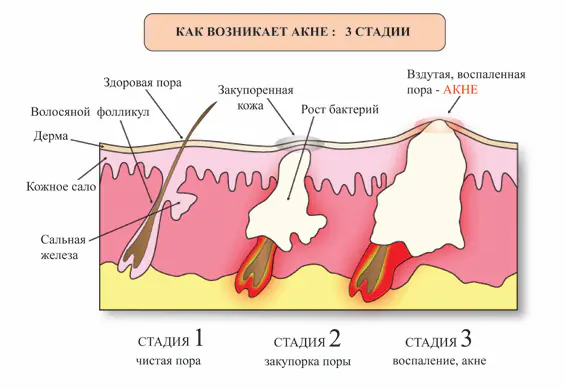
Acne appears externally rashes, they come in several types:
- acne blackheads, visible when examining the pores;
- acne-like whiteheads, small bumps above the surface of the skin;
- papules, small inflamed areas of skin, without accumulation of exudate inside;
- pustules, hollow formations with liquid contents inside them (clear or purulent effusion);
- nodes, dense subcutaneous lumps;
- cysts, areas with clear boundaries, inside which a large amount of pus accumulates.
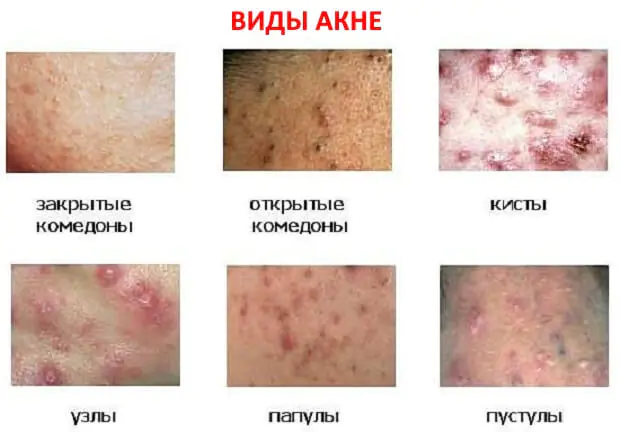
Photos of types of acne rashes
Since the disease is characterized by a wide variety of skin rashes (often a combination of them), methods of its treatment are selected individually by a dermatologist. How to treat acne correctly depends on the type, prevalence and course of the disease.
For some forms of the disease, it will be enough to properly organize daily skin care activities and select suitable products for facial and body hygiene; for others, intensive antibacterial treatment, selection of medications to resolve scar changes and improve the nutrition of the epidermis may be necessary.
ICD-10 code
Medical science has systematized the types of acne. The International Classification of Diseases (ICD 10) combines it into a separate group of skin diseases with the code - L70.0–9.
Scientists explain what it is in people and reveal clinical features every type of disease:
1. Acne ordinary. Most often it affects teenagers and young men, localizing on the face in the area of the wings of the nose, cheeks and chin.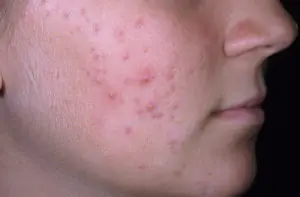
2. Globular acne. The disease manifests itself in young men in the form of formations on the skin that resemble cherries. Inside, these cysts are filled with pus; when they are torn, the walls of the cysts fall off and stick together, and as the wounds heal, scars form.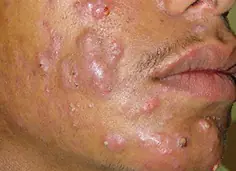
3. Smallpox acne. It is characterized by the formation of numerous, centrally necrotic, bright pink (red or purple) nodules. Most often, the disease is found in people over 40-45 years of age.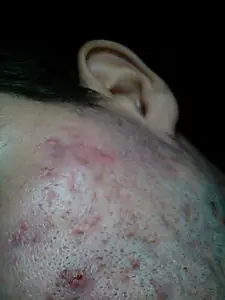
4. Tropical acne. It affects travelers (lovers of hot countries), manifests itself as widespread and isolated acne throughout the body (back, abdomen, chest), the rash can go away without treatment or fester.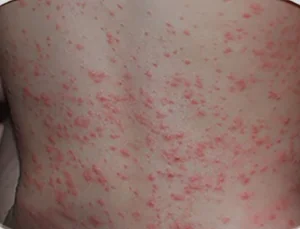
5. Baby acne. Formed, as a rule, due to metabolic disorders in children, it is characterized by the formation of small papules or pustules, very similar to an allergic rash.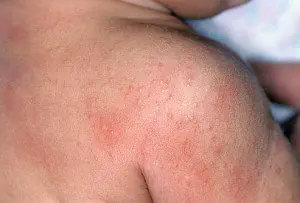
Causes
The pathogenesis (emergence and development) of the disease occurs in several stages:
- increased production of sebum by the glands due to the active work of the adrenal glands, releasing a large amount of androgens (male sex hormones) into the blood;
- accumulation of desquamated (dead) cells in the skin lumens (epithelial keratosis) and clogging of pores;
- inflammation of the affected areas and the formation of acne vulgaris;
- suppuration of the rash;
- rupture of abscesses and scar formation.

Sometimes incompetence and impatience lead to the fact that patients themselves introduce an infection to the skin and the disease goes from a mild form to a complicated one.
Factors that provoke the development of this pathology include:
- changes in hormonal levels in the body (during puberty, menopause, infancy, pregnancy, endocrine pathologies, metabolic diseases);
- excess corticosteroids in people with long-term treatment with hormones or systematic use of drugs that stimulate muscle growth (steroids);
- disorders of the digestive system (diseases of the stomach, intestines, liver, pancreas);
- severe emotional distress or chronic stress;
- thermoregulation disorders;
- skin pathologies of bacterial or fungal origin;
- hereditary predisposition;
- poor hygienic skin care.
Newborn acne
The appearance of acne in children always worries parents.
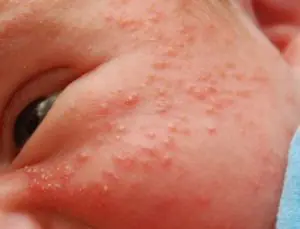
Newborn acne: photos
Often mothers blame themselves for eating disorders and eating sweet or fatty foods. Therefore, in the heat of the moment, mistakes can be made in caring for a child; their skin begins to be lubricated with baby creams and powders are often used. But acne is caused by clogged pores, so all these procedures only increase the formation of the rash. If acne in a child does not fester, it is not a pathology.
Video (about acne in infants – see from 12:20):

What should parents do if they see acne in their child:
- consult a doctor;
- keep the child clean.
This is quite enough to give the newborn time to adapt to new living conditions; acne in these cases goes away on its own, without taking medications.
Treatment
Treatment of the disease is carried out according to a general scheme, mostly using local remedies. Sometimes specialized means are used to normalize hormonal levels; in case of suppuration, a course of antibiotics is prescribed; in the presence of residual pigmentation and scars, the use of physiotherapeutic procedures and biostimulants is necessary.
General strengthening and hygienic treatment methods are actively used in acne therapy.:
1. Shower daily using neutral detergents. Cleanses the skin of excess sebum and dead cells.
2. Gymnastics classes. Normalizes peripheral blood circulation and delivery of nutrients to epidermal cells.
3. Facial massage. Allows you to improve lymphatic drainage and reduce the manifestations of inflammatory reactions. It is not performed during purulent processes (due to the risk of infection spreading into the deeper layers of the skin).
4. Walks, hiking trips at the place of residence. These activities enrich the body with oxygen and strengthen the human immune system.
It is important to remember that during treatment for acne it is undesirable:
- abuse cosmetics, do home and salon skin peeling;
- take a long steam bath, sunbathe;
- use fatty creams for face and body care.
Drugs
1. Benzoyl derivatives (Oxygel, Baziron-gel, Proderm-cream, etc.). Bactericidal agents that inhibit the growth of microorganisms in hair follicles.
2. Salicylates (Clerasil, Delax acne gel). Lotions, gels, and ointments based on them can dissolve plugs in pores (blackheads) and disinfect the skin.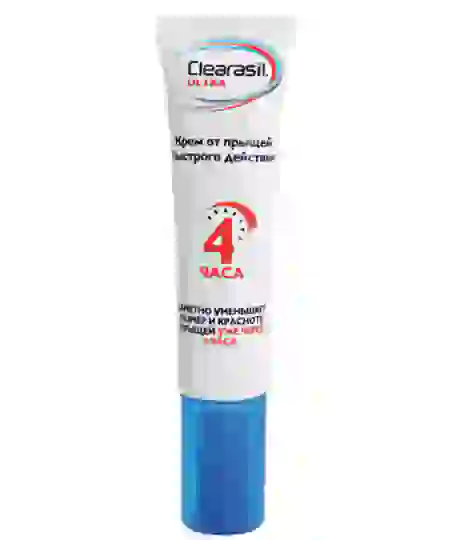
3. Retinoid products (containing vitamin A). Airol, Zorak, Klenzit and other drugs are excellent prevention of the formation of blackheads and a medicine that helps to destroy them.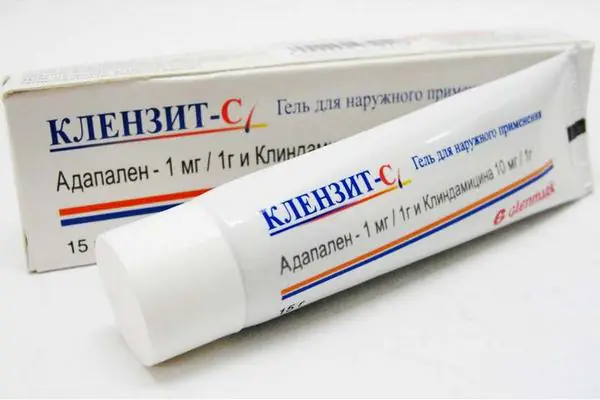
4. Azelaines (Azogel, Skinoren, Acne-derma). Products based on them help to quickly cleanse the skin of keratinized scales and destroy pathogenic flora on the skin.
5. Sulfur ointment. Used to reduce redness and swelling of acne.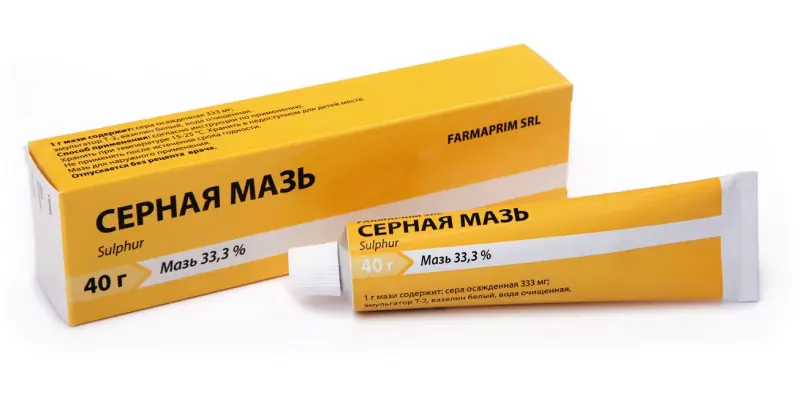
6. Antibacterial agents (Klindovit, Zinerit, Dalatsin), drugs that destroy pathogens of skin infections. Creams and gels containing them are widely used. 
Antibiotic ointments for acne are rarely used due to their heavy texture, and oral tablets are prescribed for generalized (extensive) purulent process or cyst formation.
Laser treatment
Laser treatment is an effective additional method to drug therapy for acne; patient reviews of it are mostly positive. In addition to affecting papules and pustules, pimples and blackheads, this method allows you to get rid of the consequences of suppuration and scarring.

Anti-acne (laser acne removal): photo
Procedure Anti-acne used by dermatologists for more than 30 years, it is based on laser penetration into the deep layers of the skin, while creams and ointments act superficially. The radiation, which patients experience as a slight tingling sensation and a feeling of warmth, kills bacteria, cleanses pores, and stimulates the regeneration processes of epidermal cells. Laser sessions of 15-20 minutes are carried out 2 to 6 times, with an interval between them of 3-4 weeks. The treatment is practically painless (a slight burning sensation is felt upon contact with the laser beam), and in the areas of exposure, after the procedure there remains slight redness and swelling, which disappear within a few days.
Diet
Without changing your usual diet, pimples and blackheads on the face are difficult to cure at home.
All therapeutic efforts and the use of advanced methods may not be effective if you do not limit a number of foods in your diet that stimulate the sebaceous and sweat glands.
Therefore, with acne it is important:
- give up sweet, spicy, hot, salty, smoked, fatty, fried foods or consume such foods in minimal quantities;
- do not abuse alcohol and carbonated drinks;
- It is good to include in your diet seafood rich in omega-3 acids, vegetables, herbs and fruits containing vitamins A, E, B;
- it is necessary to maintain an increased water regime, drink at least 1.5-2 liters of liquid per day (to enhance the removal of unnecessary substances).
- red fish;
- squid;
- seaweed;
- lean beef;
- oranges, carrots, mangoes, spinach, celery, tomatoes.
- sandwiches, hot dogs, burgers, french fries;
- beer, liqueurs, champagne;
- chocolate, cocoa, coffee, baked goods.
Acne is the name given to inflamed growths that appear in both teenagers and adults. Many people who are faced with this problem keep asking themselves the question: is squeezing pimples on the face dangerous? Let's try to figure this out.
Reasons for appearance
There are a variety of factors that cause skin pathologies on the face and body.
Among them:
- Adolescence. The fact is that it is during this period of life that hormonal levels are established, which is why inflammatory formations occur on the skin.
- Hyperkeratosis. As a result of intoxication of the body, vitamin deficiency or hormonal changes, a significant increase in the upper stratum corneum of the skin can occur.
- Menstruation. Immediately before menstruation, women experience a release of steroid hormones, which leads to skin problems.
- Use of low-quality cosmetics and cosmetics. Also, if you use cosmetics in large quantities and very often, this can lead to various rashes.
- Poor nutrition. Excessively fatty, fried and heavy food for the stomach can cause cosmetic problems.
- Hidden diseases of internal organs and the whole body.
- Stressful situations.
- Climate change. Sometimes banal changes in climate conditions contribute to the appearance of skin rashes.
Doctors' opinion
And yet, experts do not recommend squeezing out pimples yourself at home. This process is very delicate, and if sterility rules are not followed, the extrusion procedure can lead to serious consequences. Doctors strongly do not recommend performing this procedure in person.
However, despite this, there is a type of skin formation that is quite safe to squeeze out, naturally, only if certain rules of this procedure are observed.
Why you shouldn't squeeze pimples on your face
There are serious health risks associated with self-pimple removal. So, why shouldn’t you squeeze out inflamed purulent formations?
Appearance of scars
When mechanical pressure is applied to the skin layer, damage occurs, which can result in scars and rough scars.
These consequences are not easy to treat. Scars also worsen a person’s appearance and contribute to the development of complexes. This factor especially affects the female half of the population.
Blood poisoning
Another frightening consequence of squeezing out even seemingly harmless pimples is blood poisoning. The main reason for this is the unsterile conditions of the procedure and non-compliance with certain rules.
The fact is that the purulent contents of a pimple can be squeezed out both outward and inward, which will lead to infectious blood lesions.
Also, the infection can get through an unhealed pimple wound, which will lead to certain complications. It is especially dangerous to do such procedures in the areas of the nasolabial triangle and on the nose.
It is here that many vessels are located that supply the brain with blood. If the infection penetrates these areas, there is a high probability of developing meningitis.
Cosmetological defect
If we take into account the existing consequences of squeezing out acne vulgaris, the answer to the question becomes clear whether it is possible to remove inflammatory tumors on your own.
Video: What happens if you squeeze a rash?
Which ones can be pressed?
To decide which pimples can be squeezed out and which ones should not be squeezed out, it is necessary to classify the type of formation that has arisen.
According to their structure, skin rashes can be divided into inflammatory and those in which inflammatory processes are completely absent.
The first type of skin formations can be distinguished by:
- changes in skin color (redness);
- swelling may occur;
- the formation rises above the surface of the epidermis;
- viewing purulent contents;
- painful sensations when pressed.
Formations in which inflammatory processes do not occur look like small bulges. Such formations are called comedones, and they arise due to blockage of the sebaceous glands.
In turn, comedones are divided into several types:
- Open. The size of the rash does not exceed a couple of millimeters and looks like black dots on the skin. The saturation of the dark shade indicates the age of the neoplasm. Initially, the clogged sebaceous plug has a light shade; over time, it oxidizes in air, which leads to its darkening.
If you do not neglect special conditions and rules, comedones can be squeezed out yourself. If you ignore these norms, the squeezed comedon can become infected.
- Milia or closed comedones. They arise due to blockage of pores, but from the lower part. Outwardly they are hardly noticeable, but upon palpation they are clearly palpable. If there is a large accumulation of comedones on the face, the skin takes on a rough appearance and becomes like sandpaper.
- Pustules. Small tubercles in which purulent contents are visible through a thin layer of skin. At the top of the formation there is always a whitish dot, with inflamed skin around it. In some cases, pustules can be squeezed out on their own.
- Papules. When an infection penetrates the comedone, a papule appears. These formations can reach 1 cm in diameter and look like burgundy or red bumps. If you try to squeeze out the papule, especially at home, this will worsen the clinical picture.
So, from the above it follows that you can only squeeze certain pimples, subject to certain rules:
- small pustules can be removed;
- pimples that are deeply yellow or green should not be touched;
- You can squeeze the pus out only when the redness of the pimple subsides.
Steroid acne on the face, look at the photo, here.
If there are many of them
It is the number of pimples that is a significant factor in the safety of squeezing them out.
Acne varies in severity according to its severity:
In the first case, the formations can be removed independently, but only if certain rules are followed.
The moderate form implies the presence of a purulent formation. If the total number of inflamed formations does not exceed 10, they can be squeezed out, but together with additional treatment.
A severe and advanced form of the rash on the face is caused by the presence of large formations, the number of which exceeds 25 pieces. Squeezing such pimples is strictly prohibited, as this can lead to blood poisoning and meningitis.
Regarding the advanced form, in this case the purulent contents can infect healthy areas of the skin if it is removed out through mechanical damage to the epidermis.
Extrusion rules
First of all, it is necessary to ensure the necessary rules and standards of sterility. Only in this case will it be possible to avoid infections.
Secondly, you can squeeze out only those pimples that allow this procedure. And of course, before this procedure, it is best to consult a doctor, because in addition to external removal, internal treatment of skin pathology may also be required.
Expert advice
So, if you decide to squeeze out the formation on your face, you should follow the advice of medical experts:
- it is necessary to pre-steam the skin if there is a need to squeeze out the comedone;
- it will be easy to open the pustule if you apply ichthyol ointment to the skin at night;
- Before the removal procedure, you need to thoroughly wash your hands and face with soap;
- wrap your index fingers with a sterile bandage (thin layer);
- first wipe the acne with an alcohol solution to remove bacteria from the skin;
- you need to press your fingers directly on the root of the eel, and not on its surface;
- after removing its contents, rinse the wound with hydrogen peroxide;
- For a couple of days, refrain from applying powder and other cosmetics to your face.
Possible consequences
Of course, there are unpleasant consequences after the squeezing procedure, namely the formation of redness on the skin and wounds. Such marks cause a lot of inconvenience to their owner. But there are also more serious consequences.
Why is it dangerous?
Many people don’t even think about the seriousness of the consequences of removing acne on their own, but such manipulations can easily lead to blood poisoning, the emergence of new purulent formations and meningitis.
How to calm your face?
Naturally, after the extrusion procedure, the surface layer of the skin is damaged and acquires a red tint. There are products that can help soothe your facial skin.
Masks
Applying a soothing mask to your face can soothe irritated skin.
For this it is good to use:
- light clay;
- fresh cucumber masks;
- a mixture of calendula and honey 1:1;
- from aloe leaves and so on.
Lotions
After removing acne, you can soothe the skin with medical lotions for wiping the skin of the face. They have an antiseptic and calming effect.
You can also make your own lotion. To do this you will need chamomile color (1 tablespoon) and 500 ml of water. Bring the broth to a boil and let it brew for a couple of hours.
Crema
Antiseptic ointments and creams also help heal damaged epidermis. Typically, these drugs for external use are prescribed by a doctor, based on the nature of the skin pathology and skin type.
Photos before and after
How to get rid of the causes of whiteheads on the face. Find out further.
How to choose an effective treatment with tablets for juvenile acne with pustules? The answer is here.
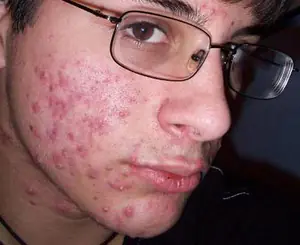
Each of us has faced the problem of acne. This is an unpleasant and troublesome phenomenon; it frightens with the unpredictability of its appearance and development. Acne is often treated incorrectly, and the main reason for rash actions is the lack of knowledge in this area. To effectively fight acne, you need to understand the types of acne, know how they differ from each other and understand the severity of the disease. If these parameters are known, then the search for a treatment regimen is simplified.
Disease severity
There are four degrees of severity of the disease.

The first one is the easiest. Light form flows smoothly, it can be seen on the face of a teenager or an adult. The first stage is characterized by a small number of blackheads and they look like closed acne or open acne (comedones). As a rule, there is no inflammatory process. However, within the first degree, several pustules are allowed. Treatment can be carried out at home, but it must take place, otherwise the disease will begin to progress. When acne disappears, there are usually no traces left.
The second stage of the disease begins when there is up to 11 pieces of different eels. It is manifested by the presence of closed acne, blackheads, redheads and pustules. It happens to both teenagers and mature people, for example, women during their menstrual periods. Self-treatment is acceptable, but if acne has not disappeared within three weeks, then you should go to a dermatologist.
The third degree is a severe form of the disease. It has already spread to the body and counts up to 40 pimples different types. You can see the inflammatory process and suppuration. Pimples look larger than in the first two stages. Post-acne appears, which looks like stagnant spots and scars. At the third stage, acne “multiplies” uncontrollably, capturing more and more new territories, so you need to urgently go to the doctor. If this is not done or if you begin to treat it yourself, it can result in ugly scars and blood poisoning.
At the fourth stage of the disease, there is already a whole “army” of pimples on the skin with various shades and sizes. Often several pimples merge together and form cysts and nodes. Dark spots and large scars form on the skin, and the affected areas bleed and fester; at the slightest friction of clothing, breakouts form. As a rule, the back, shoulders, and chest are completely affected. If professional treatment by a dermatologist is not carried out at this stage, then this can be dangerous not only for the beauty of the body, but also for health in general.
It is important to know that acne is a multifaceted disease, its course depends on the individual skin. Therefore, there is no uniform classification system for acne, but some types of acne have been studied, correctly diagnosed and treated by dermatologists.
Types of acne
All acne are divided into two types:
- No inflammatory process.
- With an inflammatory process.
Pimples without signs of inflammation, in turn, are divided into open comedones, which look like blackheads, and closed comedones, which look like whiteheads.
Acne with inflammatory symptoms has the following names:
How to determine whether there is an inflamed acne on the face or not? The appearance of the first one is larger and it catches the eye, disfiguring the face. There are signs of tissue swelling, redness, suppurationbecause there is an infection. Inflamed pimples are often painful and uncomfortable. If the acne has no signs of inflammation, then at one moment it can turn into an inflamed one; all you need to do is introduce an infection into the skin pore.
Acne without inflammation
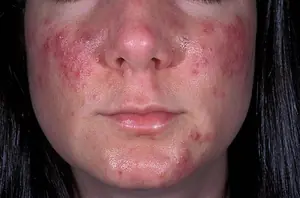
Comedones appear as a result of blockage of the ducts of the sebaceous glands. These pimples contain thick fat, dead cells and epithelial scales.
If such a blockage forms outside the pores, then open comedones occur. Why are they black? Since the pores are open, an oxidation reaction occurs caused by the action of oxygen on lumps of fat. As a rule, blackheads do not cause any trouble, however, if an infection occurs, the situation becomes the opposite.
Closed comedones or whiteheads, wen occur when there is a blockage of fat in the lower part of the pores. They resemble blood clots because they have no way out. They are invisible to the eye and are often felt only by touch. However, some of them are still noticeable, as they rise above the surface. They are called millet grains because they resemble grains.
Closed comedones form on the face in the area of the cheeks, cheekbones, forehead and they don’t bother me too much - there is no inflammation or pain. However, despite some harmlessness, they are still dangerous, since they are capable of combining with neighboring inflammatory acne under the skin. As a result, a voluminous cavity is formed, which is gradually filled with pus. Thus, the wen can worsen the situation significantly.
Inflammatory acne
Acne with an inflammatory process is also classified. For example, papules are comedones with inflammation, often arising from wen. In diameter their size is up to 1 cm, look like pink or red balls that rise above the surface of the skin. If you press a little, it temporarily changes color to white. Lacks white head. If the papule has grown from a blackhead, then you can see a dark fat plug. These acne are divided into types:
- Superficial. Their size is up to 5 mm, after disappearing they leave no traces, sometimes a temporary stain forms.
- Deep papules or nodules. They occupy the entire thickness, their diameter is from 1 to 3 cm. They are usually painful, colored red or blue-purple, when they disappear, they leave spots and scars on the skin that disfigure the appearance.
- Cysts. With severe inflammation, dense formations with pus are formed. Often several merge into one, forming a chain of cyst-like papules. If you touch it, you might think that it is a dense capsule. They consist of chambers that are connected by fistulas. They cause a lot of trouble and leave a mark behind.
Acne on the face: causes and treatment
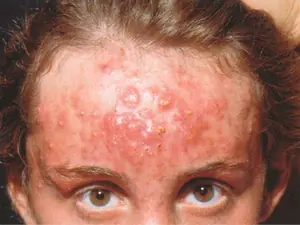
As a rule, acne appears due to hormonal imbalance. It occurs in adolescence, before the onset of the menstrual cycle, during pregnancy and breastfeeding, and at menopause. Often hormonal disorders lead to hyperkeratosis when the sebaceous glands do not work properly. This pathology is characterized by an increase in the upper, stratum corneum layer of the skin. As a result, blockage of the sebaceous glands occurs, which leads to acne.
Open pores are a target for pathogens. Therefore, acne often occurs as a result of skin damage by subcutaneous mites or fungi. The second reason for acne is clogged pores, for example, when decorative cosmetics are used. With improper care, acne almost always forms on the face.
The reasons for the formation of acne also lie in lipid metabolism disorders, which are signaled by increased activity of the sebaceous glands. Typically, an imbalance is caused by hot summers, abuse of tanning, both solar and artificial, and baths or saunas. An incorrect lifestyle can also provoke the appearance of acne - these are bad habits, poor nutrition, when you eat fatty, salty, fried or spicy foods.
Other reasons include allergic reactions to an irritant, as well as lack of vitamins. Acne can occur during a cold, when the body experiences a decrease in immunity, resulting in disruption of the sebaceous glands. But they can also be provoked by internal diseases such as dysbiosis and cholelithiasis. In this case, acne is localized on the forehead. If endocrine or digestive system disorders occur, then the chin is affected. On the nose - you need to get your immune system in order.
How to treat?
Doctors and cosmetologists never tire of repeating that squeezing pimples on your own is contraindicated! As a result of home self-medication, unpleasant consequences arise, which are expressed in the spread of acne to new areas and secondary blood poisoning with the appearance of age spots and scars. Treatment of acne is a complex process, it includes a number of stages:
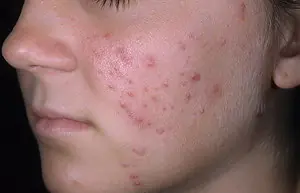
Prevention of the appearance of new comedones. Prevention is based on the selection of the necessary care products for problem skin, improvement of the body as a whole, which includes proper nutrition, stimulation of the immune system, as well as monitoring the effect of treatment drugs on the body.- Removing existing comedones with the help of medications, which include azelaic acid, benzoyl peroxide, tazarotene and others.
- Reducing the amount of sebum using hormones and retinoids. This figure needs to be reduced to 30% or more.
- Exfoliation of the upper layer of the epidermis using peels that contain salicylic or glycolic acid.
- Facial cleansing using gentle ultrasound or other hardware-based, low-traumatic methods. This is an excellent alternative to chemical peels.
- Antibacterial drugs are used for local and internal treatment of inflammatory processes.
- Using various types of dermabrasion, laser resurfacing, cryotherapy, mesotherapy, ozone therapy and other methods, cosmetic removal of the effects of acne is carried out.
- If necessary, parallel treatment of body systems is prescribed - treatment of the digestive system, gynecological, endocrine diseases.
Preventing acne
To prevent the occurrence and recurrence of acne you need follow a number of the following rules:

The skin should be cleansed in the mornings and evenings with special mild products, for example, a water-soluble tonic, which will not only cleanse, but also moisturize.- Makeup must be washed off every evening, especially if it is liquid powder or foundation.
- For washing, use water at a moderately comfortable temperature - barely warm or cool.
- It is necessary to regularly exfoliate dead skin particles with special scrubs or peels. To avoid putting a lot of stress on your skin, choose one product. It is better if it is a chemical peel, it is gentler than a scrub.
- Facial skin needs hydration and antioxidants. To do this, choose household products that are suitable for your facial skin type.
- Locally it is necessary to use antibacterial drugs, for example, based on benzene peroxide.
- You should regularly use sunscreen, this is especially important after procedures to exfoliate dead skin cells.
- It is necessary to regularly change clothes, bed linen, and face towels - this will prevent unnecessary contact of microorganisms with the skin.
So, the main place in preventing the appearance of acne is prevention with proper skin care. But if acne does appear and is spreading, then you should not wait, much less start treating yourself; you should immediately go to a dermatologist to stop the inflammatory process.



